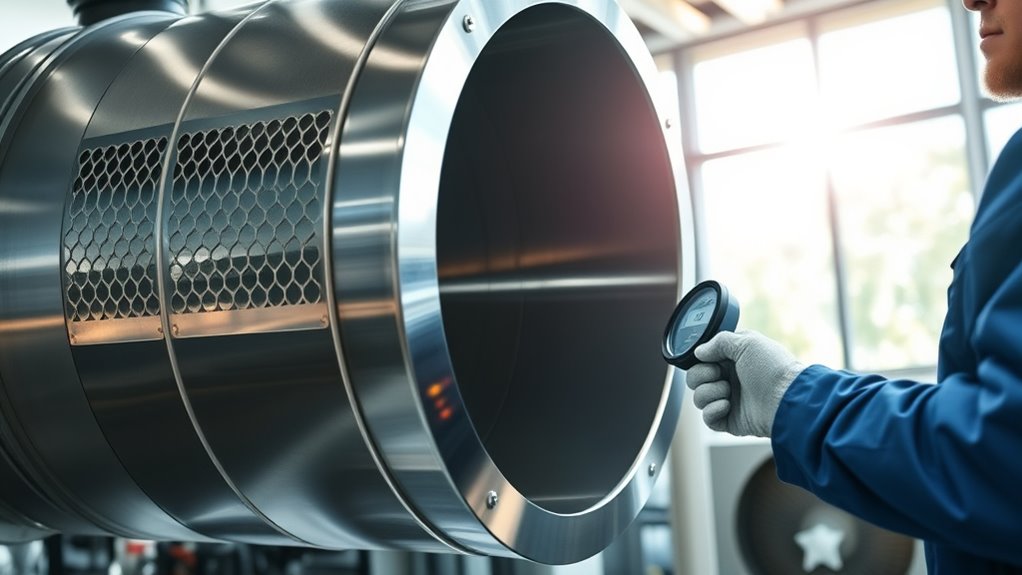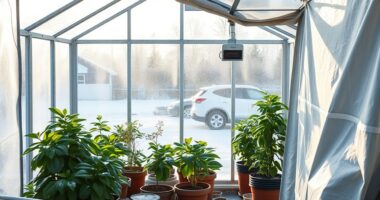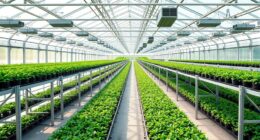To guarantee proper airflow year-round, you should regularly replace your air filters every 1-3 months and schedule professional duct cleaning every few years to remove dust, mold, and debris. Keep vents unobstructed and inspect your ventilation system for any issues. Appropriate maintenance prevents system strain, improves indoor air quality, and boosts efficiency. Staying on top of these tasks helps your system work smoothly all year. If you continue, you’ll discover more tips to maintain ideal airflow.
Key Takeaways
- Regularly replace air filters every 1-3 months to maintain airflow and indoor air quality.
- Schedule professional duct cleaning every few years to remove dust, mold, and debris.
- Inspect ventilation systems frequently for blockages or damage to ensure optimal airflow.
- Keep vents and registers clean and unobstructed to promote consistent ventilation throughout the year.
- Stay informed on maintenance best practices to prevent system strain, reduce energy costs, and ensure healthy indoor environments.

Have you ever wondered why proper ventilation maintenance is essential for a healthy indoor environment? The truth is, your home’s air quality depends heavily on regular upkeep of your ventilation system. Over time, dust, dirt, and debris accumulate in your air filters and ductwork, reducing airflow and trapping pollutants. That’s why air filter replacement is a crucial step in maintaining efficient ventilation. When you replace filters regularly—generally every one to three months—you prevent the buildup of allergens, mold spores, and other airborne particles that can cause respiratory issues or exacerbate allergies. Fresh filters ensure your system runs smoothly, improving indoor air quality and reducing energy costs because your HVAC doesn’t have to work as hard to circulate air. Alongside filter replacement, duct cleaning plays a vital role in maintaining a healthy ventilation system. Over the years, ducts can become clogged with dust, pet hair, mold, and even pest droppings, which not only hampers airflow but can also introduce unpleasant odors into your living space. Scheduling professional duct cleaning every few years helps remove these contaminants, ensuring that the air you breathe is as clean as possible. It also helps your system operate more efficiently, lowering energy bills and prolonging the lifespan of your HVAC equipment. Neglecting these maintenance tasks can lead to a cascade of problems. Clogged filters force your system to work harder, increasing wear and tear, and possibly causing system failures. Dirty ducts, meanwhile, can become breeding grounds for mold or bacteria, which can circulate throughout your home and impact your health. Regularly inspecting and replacing air filters is a simple yet effective way to keep your system functioning optimally. It’s a quick task you can do yourself, but don’t hesitate to call in professionals for duct cleaning if it’s been a while since your last service. Additionally, keeping an eye on archives for updated information and tips can help you stay informed about the latest maintenance practices. Remember, maintaining good ventilation isn’t just about comfort; it’s about protecting your health and ensuring your home remains a safe, fresh environment. By committing to these routine tasks—air filter replacement and duct cleaning—you’re taking proactive steps toward better indoor air quality and energy efficiency. Your lungs and your wallet will thank you for the effort, as cleaner air and lower utility bills become your everyday reality. Proper ventilation maintenance isn’t complicated; it’s an investment in your well-being that pays off year-round.
Frequently Asked Questions
How Often Should I Replace My Ventilation Filters?
You should replace your ventilation filters every 1 to 3 months, depending on usage and filter type. Following a regular maintenance schedule helps guarantee proper airflow and indoor air quality. Check your filters regularly, especially during peak seasons, and replace them when they look dirty or clogged. Proper filter replacement not only maintains efficiency but also extends your system’s lifespan, saving you money in the long run.
Can I Perform Ventilation Maintenance Myself?
Yes, you can perform ventilation maintenance yourself. Start with DIY tips like turning off power before working on the system and wearing gloves for safety. Check and replace filters regularly, and clean vents to prevent dust buildup. Always follow safety precautions, such as consulting your system’s manual and avoiding complex repairs if you’re unsure. This keeps your ventilation working efficiently and ensures a healthier indoor environment.
What Are Signs of Poor Ventilation System Performance?
You notice airflow blockages or musty odors lingering in your space—that’s a clear sign your ventilation system isn’t performing properly. When airflow is restricted, fresh air can’t circulate, leading to stagnant, stale air. Musty odors often indicate mold or mildew buildup, which worsens with poor ventilation. Be alert for uneven airflow, excessive dust, or humidity issues, and address them promptly to restore healthy, efficient airflow in your home.
How Does Outdoor Air Quality Affect My Ventilation System?
Outdoor air quality critically impacts your ventilation system. When outdoor air has high levels of air pollution or indoor allergens, your system may bring in contaminants, reducing indoor air quality. This can lead to health issues and decreased comfort. To minimize these effects, make certain your ventilation system includes filters that trap pollutants and allergens, and consider using air purifiers or upgrading filters during high pollution seasons.
Are There Energy-Efficient Ventilation Options Available?
Yes, there are energy-efficient ventilation options available. You can choose energy-saving fans that use less power while maintaining airflow, helping you save on energy costs. Sustainable ventilation systems, like heat recovery ventilators or energy-efficient ERVs, optimize airflow and reduce waste. These options allow you to improve indoor air quality without sacrificing energy conservation, making your home more eco-friendly and cost-effective year-round.
Conclusion
Now that you know the importance of keeping your ventilation system in top shape, imagine what could happen if you overlook it just for a season. Dust buildup, mold, and poor airflow might silently take hold, sneaking into your home when you least expect it. But with regular maintenance, you can stay one step ahead—breathing easy year-round. Don’t wait for problems to appear. Take action now, and keep the fresh air flowing through your home, always.









